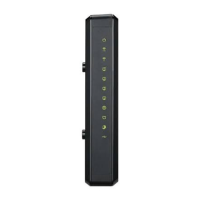Chapter 7 Wireless
VMG3925-B10A User’s Guide
101
7.9 The Channel Status Screen
Use the Channel Status screen to scan wireless LAN channel noises and view the results. Click
Network Setting > Wireless > Channel Status. The screen appears as shown. Click Scan to
scan the wireless LAN channels. You can view the results in the Channel Scan Result section.
802.11 Mode Select 802.11b Only to allow only IEEE 802.11b compliant WLAN devices to associate with
the VMG.
Select 802.11g Only to allow only IEEE 802.11g compliant WLAN devices to associate with
the VMG.
Select 802.11n Only to allow only IEEE 802.11n compliant WLAN devices to associate with
the VMG.
Select 802.11b/g Mixed to allow either IEEE 802.11b or IEEE 802.11g compliant WLAN
devices to associate with the VMG. The transmission rate of your VMG might be reduced.
Select 802.11b/g/n Mixed to allow IEEE 802.11b, IEEE 802.11g or IEEE802.11n
compliant WLAN devices to associate with the VMG. The transmission rate of your VMG
might be reduced.
802.11
Protection
Enabling this feature can help prevent collisions in mixed-mode networks (networks with
both IEEE 802.11b and IEEE 802.11g traffic).
Select Auto to have the wireless devices transmit data after a RTS/CTS handshake. This
helps improve IEEE 802.11g performance.
Select Off to disable 802.11 protection. The transmission rate of your VMG might be
reduced in a mixed-mode network.
This field displays Off and is not configurable when you set 802.11 Mode to 802.11b
Only.
RIFS
Advertisement
Select Auto to enable the Reduced Inter-frame Spacing (RIFS) feature. It improves the
Device’s performance by reducing the amount of dead time required between OFDM
transmissions. Select Off to disable the feature.
Preamble Select a preamble type from the drop-down list box. Choices are Long or Short. See
Section 7.10.7 on page 108 for more information.
This field is configurable only when you set 802.11 Mode to 802.11b.
RX Chain Power
Save
Select Enable to activate the RX Chain Power Save feature. It turns off one of the Receive
chains to save power when it is not in use. Select Disable to disable this feature.
OBSS
Coexistence
Select Enable to allow the coexistence of 20 MHz and 40 MHz Overlapping Basic Service
Sets (OBSS) in wireless local area networks. Select Disable to disable this feature.
XPress
TM
Technology
Select Enable for higher speeds, especially if you have both IEEE 802.11b and IEEE
802.11g wireless clients. The wireless clients do not have to support XPress™ Technology,
although the performance enhancement is greater if they do. Select Disable to disable this
feature.
WPS 2.0 Select Enable to support WPS 2.0 which enhances WPS security and flexibility on
configuration. Select Disable to disable this feature.
Apply Click Apply to save your changes.
Cancel Click Cancel to restore your previously saved settings.
Table 27 Network Setting > Wireless > Others (continued)
LABEL DESCRIPTION

